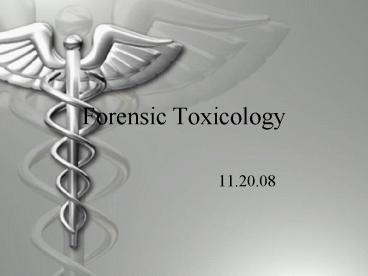Forensic Toxicology - PowerPoint PPT Presentation
1 / 17
Title:
Forensic Toxicology
Description:
Forensic Toxicology 11.20.08 Deaths Investigated by Forensic Toxicologists Accidental Poisonings Drug Abuse Cases Suicidal Poisonings Homicidal Poisonings Main ... – PowerPoint PPT presentation
Number of Views:871
Avg rating:3.0/5.0
Title: Forensic Toxicology
1
Forensic Toxicology
- 11.20.08
2
Deaths Investigated by Forensic Toxicologists
- Accidental Poisonings
- Drug Abuse Cases
- Suicidal Poisonings
- Homicidal Poisonings
3
Main Questions Addressed by Forensic Toxicologist
- Is a drug or poison present? If so, what is the
substance? - How much of the substance is present? Is the
concentration great enough to cause or contribute
to death? - How was the drug/poison administered?
4
Properties of Ideal Poison
- Undetectable by senses
- Soluble in water
- Delayed effect
- Easily obtained
- Non-traceable
- Symptoms mimic actual disease
- Undetectable by scientific instruments
- Potent
5
Potencies of Various Poisons
- Agent
- Botulinum toxin
- Ricin
- Strychnine
- Sodium arsenite
- Sodium cyanide
- Thallium
- Lethal Dose
- 0.05 mg
- 0.5 mg
- 100 mg
- 200 mg
- 250 mg
- 1000 mg
6
General Classes of Poisons
- Gases HCN, CO
- Metallic Poisons As, Sb, Pb, Li, Hg, Tl
- Non-volatile organics
- Corrosive poisons strong acids/bases
- Salts NaCN
- Alkaloids
- Pesticides
7
Carbon Monoxide (CO)
- Normal level of 1-3 in body (up to 10 in
smokers) - Fatal level at autopsy considered to be gt50 for
a healthy middle-aged male - CO prevents Oxygen binding to hemoglobin (red
blood cells) - Leads to suffocation
- CO victims have cherry pink color
8
Metal Poisons
- Most common As2O3 (arsenic)
- Death within 24 hours
- Can be given in trace amounts over long periods
of time - Symptoms
- Vomiting
- Diarrhea
9
Alkaloids
- Nitrogen-containing organic base
- Found in Plants and fungi
- Strychnine most common
- Death from muscle over-contraction, leading to
respiratory system failure - Spasms and convulsions
10
Pesticides
- Many (most?) of the pesticides we spray on our
lawns, gardens, etc. are poisonous - Growing in popularity
- Easy to obtain
- Common enough that it wont raise suspicions as
quickly if traces found
11
Toxicological Analysis of Tissues
- Collect sample of all body fluids
- Collect samples from organs and tissues
- Begin analysis as quickly as possible after death
due to quick metabolism of toxins - Look for traces of poison OR their metabolic
product (what toxin is changed into when broken
down)
12
Samples Collected at Autopsy
- Fluids
- Blood up to 100mL
- Urine 100 mL
- Bile all available
- Vitreous all available
- Gastric contents 50g
- Soft Tissue
- Liver 100g
- Brain 100-200g
- Kidney 50g
- Lung 50g
- Spleen 50g
13
Intentional Poisoning Trends
- Perpetrator Profile
- Caucasian
- Male
- Average or above IQ
- Underachiever
- Personality defect
- Non-confrontational
- Non-athletic
- Neat, orderly, meticulous
- Loner
- Gender
- Male 46
- Female 39
- Unknown 16
14
Top 5 Homicidal Poisons
- Arsenic 31
- Cyanide 9
- Strychnine 6
- Morphine 3
- Chloroform 3
15
Possible Symptoms
- Constricted/dilated pupils (opioids, organic
phosphates) - Breath odor (arsenic smells of garlic)
- Hair loss (Thallium)
- Convulsions (strychnine)
- Paralysis (botulism)
- Coma (depressants, hypnotics)
- Skin color (COred, nitritesblue)
- Skin appearance
- (arsenic hyperkeratosis, warts)
- (dioxin chloracne)
16
TCDD (dioxin) Chloracne Poisoning of Victor
Yushchenko just before Ukraine presidential
election
17
(No Transcript)

